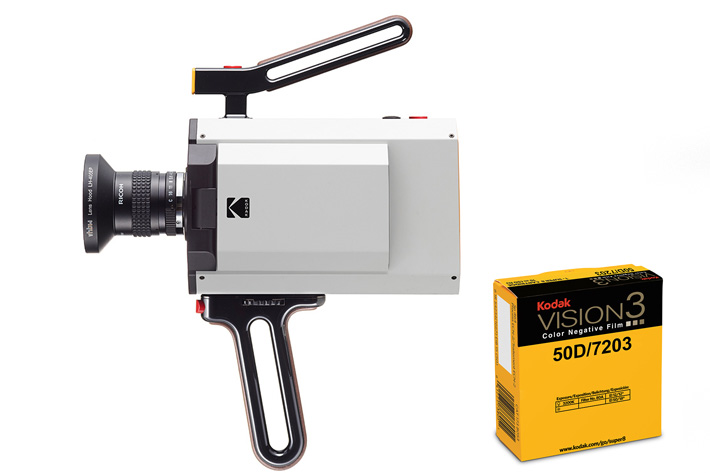
According to Kodak, the time for Analogue Renaissance is now. The company shows at CES 2017 what it has been working on: a camera and film processing ecosystem to match the excitement of last year’s announcement. Is Super 8 really coming back?
Last year, when told that Kodak wanted to revive the format, Christopher Nolan said “The news that Kodak is enabling the next generation of filmmakers with access to an upgraded and enhanced version of the same analog technology that first made me fall in love with cinematic storytelling is unbelievably exciting.” This year, on Kodak’s website dedicated to the camera, multiple authors speak about their experience and love with Super 8.
Advised and coached by leading filmmakers while drawing inspiration from Kodak’s past as well as the latest advances in sustainable manufacturing and design, the new Super 8 camera mixes the medium from the past with the novelty of the first LCD screen on a Super 8 camera and the option to connect this film camera to an ecosystem of other devices to make it easy to create, share and archive. Kodak says it brought together the best mechanical fabricators on earth, and joined efforts with celebrated industrial designer Yves Behar and his team at FuseProject in San Francisco.The result of this collaboration is the first in the next generation of film cameras for a new generation of creators.
This year, visitors of the aptly named The Kodak Studios, located at LVCC South Hall 1, Booth# 20619, can see functioning prototype models of the new Limited Edition KODAK Super 8 camera in action and view test footage demonstrating the camera’s ability to capture 8mm images with incredible quality.
Over the past few months, engineers have been working, filmmakers have been testing and the camera is on its way. In addition to the Limited Edition camera, the company is developing a range of cameras to suit all types of users at various price points.
“We listened to the community of directors, cinematographers and amateurs passionate about film. We are working hard to ensure the camera is worthy of the Kodak name,” said Brian Cruz, VP and GM, Consumer Products, Kodak. “It is important to do this right, and we are very excited to be on track to perfect our vision.”
Combining the classic features of Super 8 with digital functionality, the KODAK Super 8 camera is designed to put the unique look of the format into the hands of a new generation. The Limited Edition Super 8 camera will be available in Spring 2017, with consumer versions to follow.
To know more about the system read our previous coverage of the Kodak Super 8 Revival Initiative. Download the 21 page booklet from Kodak to read all cinematographers and authors, from Quentin Tarantino to Steven Spielberg, have said about the new Super 8 camera.
With the return of Super 8 cameras, you also need film. From its beginnings as the home movie media of the 60’s, today’s Super 8 mm film is alive and well and making it possible for virtually anyone to bring the unmistakable “look and feel” of real film to the screen. More than fifty years after its introduction, this small gauge film still provides an easy, inexpensive way for students and enthusiasts to work at film resolutions and color depths.
Kodak wants this analogue renaissance to be accessible to everyone, so to make it easier and more affordable for up-and-coming filmmakers, the KODAK Educational Allowance Program offers significant price breaks on KODAK Motion Picture Films. KODAK VISION3 Films deliver the unsurpassed image quality, real-world flexibility, digital compatibility, and archival stability that you demand.
There are four Kodak emulsions to choose from:
KODAK VISION3 50D Color Negative Film 5203/7203
The world’s finest grain film.
KODAK VISION3 500T Color Negative Film 7219
A high speed film featuring several technical innovations that deliver improved exposure latitude-so you can capture an amazing amount of shadow detail with noticeably lower grain, or rely on the extended highlight latitude and follow the action into bright light without worrying about blown-out details. Process ECN-2.
KODAK VISION3 200T Color Negative Film 7213
Performs superbly in both controlled interiors and in challenging high-contrast situations. Increased highlight latitude so you can move faster on set a pull more detail out of highlights. Reduced grain in shadows so you can push the boundaries of underexposure and still get outstanding results. KODAK VISION3 200T Color Negative Film 7213 delivers the image structure of a 100-speed film with the versatility of a 200-speed product, offering you the benefits of two films in one. Process ECN-2.
KODAK TRI-X Reversal Film 7266
A high-speed, panchromatic, black-and-white film suitable for general interior photography with artificial light. It can also be used in daylight and is particularly useful for sports pictures taken at regular speed or slow motion in weak light. This film is characterized by excellent tonal gradation and sharpness. Process D-94A.
